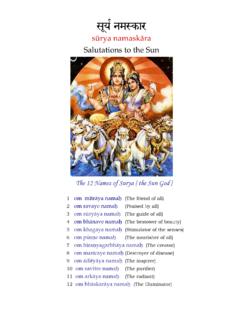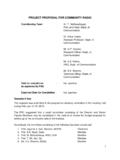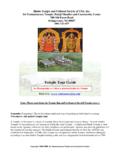Transcription of SURYA NAMASKAR 12 POSTURES OF SURYA …
1 SURYA NAMASKAR . 12 POSTURES OF SURYA NAMASKAR . Introduction: Known variously as SURYA Namskar or Prostrations to Sun or Sun Salutation, the SURYA NAMASKAR is one of the best exercises that people can perform. The benefits accruing from these exercises are unique and excellent. This is a yoga based exercise and it is customary to perform SURYA NAMASKAR after performing loosening yoga exercises. The human being can be thought of consisting of pancha kosas' (or five sheaths) consisting of the Annamaya (or Body), Pranamaya (or Breath), Manomaya (or Mind), Vijnanamaya (or Intellect) and Anandamaya (or Bliss) sheaths. These same five kosas can be further grouped into Gross (or Sthula), the Annamaya or body sheath, Subtle (or Sukshma) consisting of the pranic, mental and intellectual sheaths and the Causal (or Karana), the Bliss sheath.
2 Properly performed SURYA NAMASKAR impacts and influences all five sheaths the body, the breath, the mind, the intellect and the bliss thus providing to the performers of these exercises the benefits for the Sthula (Gross), Sukshma (subtle) and Kaarana (Causal) bodies. Whereas conventional exercises of all forms including aerobic, weight lifting, walking, jogging and running are designed to provide benefits to the physical body and its various component organs including joints and muscles, SURYA NAMASKAR provides benefits of a holistic nature by working on the physical body, praana (breathing), mind, intellect and the bliss components (or kosas) of the entire human personality. In that sense, SURYA NAMASKAR can be considered to be a personality development tool and must be included as part of one's wellness program NAMASKAR : The SURYA NAMASKAR is performed usually early in the morning facing the morning rising Sun.
3 The Namskar is done in 12 steps, each step having its own posture (including position and form). with its own breathing pattern (inhalation or exhalation), and its own mantra. SURYA NAMASKAR 1. The SURYA NAMASKAR POSTURES and Breathing Patterns: The 12 POSTURES are: 1. Stand facing the Sun with palms folded and both the thumbs touching the chest. Breathing: Inhale while raising the hands and exhale as hands are brought down to chest level 2. Raise hands upward, with feet firmly on the ground, bend backwards, stretch arms fully. Breathing: Inhale 3. Slowly bend forward, hands touching the earth with respect, head touching the knees. Breathing: Exhale SURYA NAMASKAR 2. 4. Set both hands with the palms down firmly on the ground, pull the left leg backward, raise the head looking at the Sun, full weight resting on the two palm and ten fingers.
4 Breathing: Inhale 5. Bring right leg back close to left leg, keeping hands and legs straight, bend the body at the hip forming an arch, just like a mountain, known as parvathasan or mountain pose'. Breathing: Exhale 6. Stretch yourself fully on the ground in the Saashtanga NAMASKAR pose (all eight anga' or parts of the body on the ground head, thigh, eyes (sight), mind, word, feet, hands and ears (hearing)). In reality, feet, knees, thighs, chest, forehead touch the ground with the hands stretched out and in folded position, with your mind and thoughts on the full NAMASKAR , then slowly turn the head to the sides first to left and then to right so that each ear touches the ground. Breathing: Inhale first and then Exhale fully. SURYA NAMASKAR 3. 7. Slowly raise the head, bend backward as much as possible, hands straight, in the cobra pose.
5 Breathing: Inhale 8. Parvathasan same as Step 5. Breathing: Exhale 9. Same as Step 4 with the difference that the right leg is brought forward. Breathing: Inhale SURYA NAMASKAR 4. 10. Same as Step 3. Breathing: Exhale 11. Same as Step 2. Breathing: Inhale 12. Same as Step 1. Breathing: Exhale, Inhale and Exhale. SURYA NAMASKAR 5. Mantras: There are 12 mantras with four parts to each mantra. The first part is the chanting of Aum, the second part is the chanting of a bija mantra', the third part is a part of a Rik from the Rig Veda and the fourth part is the addressing of one of the 12 names of Sun. There are six bija mantras. Each mantra consists of h', r', vowel and ends in m'. The bija mantras are: hraam', hreem', hruum', hraim', hroum' and hraha' (where the vowels are aa', ee', uu', ai', ou' and visarga or hah'.)
6 The twelve names of Sun are: Mitra, Ravi, SURYA , Bhanu, Khaga, Pushan, Hiranyagarbha, Marichi, Aditya, Savitha, Arka & Bhaskara. These six Bija Mantras are repeated in sequence to cover the twelve names of the Sun God. The three Rig Vedic hymns are used in the 12 mantras (one-quarter of the hymn used with each of these 12. names). The chanting of AUM mantra activates stomach, heart, brain and the overall body/mind, thus creating vibrations in the associated chakras. Digestion, respiratory and sensory activities go thru the powerful lens of AUM turning intellect and memory into sharp and powerful tools. The root alphabets of the Bija Mantra or Bija akshara are: h' Heart is the source of its pronunciation. It empowers the heart to perform all its functions in a better manner.
7 R' The center of the forehead is the source of its pronunciation. The palate and the brain are gently buffeted by the vibration. The result is good taste and better intellect. swar (vowel) a', i or e', u', ai', ou', ha' - various organs are impacted by the sound vibrations, making these organs strong and sensitive. Long aa as in hraam': vibrations stimulate brain, heart & respiratory organs Long ee as in hreem': vibrations work on palate, vocal cord & nasal area Long uu as in hruum': vibrations work on stomach, small intestine, pancreas (make digestive system strong). Combined Vowel ai' as in hraim': vibrations work on kidney and urinary passage making the organs strong and sensitive. SURYA NAMASKAR 6. Combined Vowel ou' as in hroum': vibrations work on excretory system making organs strong and sensitive.
8 Visarga' (hah) as in hraha; sound vibrations work on the chest and the vocal cord. anunasik' created in the nasal area, the vibrations keep the nasal passage clean, soft and wet. The back bending of the body (as in step 2 when the front of the body gets elongation while the back and the spine gets compressed), the forward bending to touch the ground with the hands (as in step3 when the front of the body gets compressed while the back and the spine gets elongated), the stretching and bending in other poses (as in steps 4, 5 and 6) as well as in steps 7 thru 12 provide the type of benefits to the human body that are not available by any other exercise regimen. The mantras chanted while performing the NAMASKAR generate minute vibrations in the body which helps and corrects functioning of all systems of glands in the body.
9 The whole NAMASKAR process tones up the functioning of all systems in the body like sensory, respiratory, circulatory, digestive and nervous systems. Balanced state of mind and concentration and wide memory powers also result. These explanations are provided here to illustrate how our ancient masters have, by their insight, study and research, understood how the various organs of the body can be kept in optimal and strong functioning levels. Their knowledge and understanding of the externals and the internals are amazing. Modern science is only gradually scratching the surface of the vast knowledge hidden in our hoary scriptures and in the practices of our Rishis. The mantras are chanted in the following manner: Aum followed by bija mantra followed by one paada of the Rik (from Rig Veda) followed by one of the names of Sun.
10 The 12 mantras (with the 6 bija mantras appearing twice) are: Om Hraam Udhyannadhyamitramahaha' Mitraya Namaha (Mitra - friend). Om Hreem Aarohannuththaraamdivamm' Ravaye Namaha (Ravi - radiance). Om Hruum Hridrogam mama SURYA ' Suryaya Namaha ( SURYA dispeller of darkness). SURYA NAMASKAR 7. Om Hraim Harimaanam cha naashaya' Bhanave Namaha (Bhanu Shining with luster). Om Hroum Shukeshu May Harimaanamm' Khagaya Namaha (Khaga all pervading). Om Hraha Ropanaakaasu dhadhmasi' Pooshne Namaha (Pushan mystic fire which gives). Om Hraam Atho Haaridraveshu May' Hiranyagarbhaya Namaha (Hiranyagarbha golden colored). Om Hreem Harimaanannidhadhmasi' Marichaye Namaha (Marichi Ray of light). Om Hruum Udagaadhayamaadithyah' Adityaya Namaha (Aditya Sun, aspect of Vishnu, Son of Aditi).






